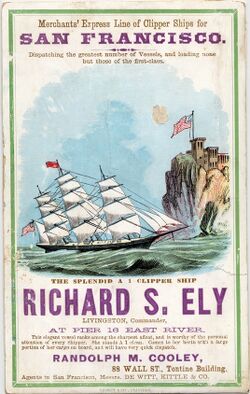Mary Ann (pilot boat)
Topic: Engineering
 From HandWiki - Reading time: 4 min
From HandWiki - Reading time: 4 min
| History | |
|---|---|
| Name: | Mary Ann |
| Owner: | New York Pilots, David A. Thomas |
| Operator: |
|
| Launched: | 1830s |
| Out of service: | Late 1860s |
| Homeport: | New York |
| General characteristics | |
| Class and type: | Schooner |
| Displacement: | 45 tons TM |
| Propulsion: | sails |
| Sail plan: | Schooner-rigged |
The Mary Ann, No. 13 was a 19th-century Sandy Hook pilot boat built for the New York City pilots. She helped transport maritime pilots between inbound or outbound ships coming into the New York Harbor. In 1860, the Mary Ann, was one of only twenty-one pilot boats in the New York and New Jersey fleet. She went ashore outside Sandy Hook in 1863.
Construction and service
There are many reports of the pilot-boat Mary Ann from 1830 to 1863 in the New York newspapers. One of the first reports of the Mary Ann appears on 1837, when pilots James M. West and Edward Maull, of the pilot boat Mary Ann passed the pirate ship Susquehennah near Cape Henlopen Light, Delaware.[1] Thomas Rowland, one of the pilots on board the Mary Ann said that they passed the Susquehennah and could see a cross in her fore topsail.[2]
John Taylor did his apprentice on the 45-ton pilot boat Mary Ann in the early 1830s.[3][4]
In 1830, Richard Westley, in the pilot boat Mary Ann, came across a shipwrecked schooner at Bareford Bar.[5] In 1833, Westley, in the Mary Ann, used the Breakwater as a harbor in bad weather.[6]
On April 23, 1852, pilot boat Mary Ann launched a yawl with two men to bring back a pilot that was on the bark Southerner in a heavy storm. The yawl came alongside the bark, when it filled with water and capsized, drowning the two men.[7]
On April 6, 1856, the pilot boat Mary Ann, No. 13 was on station when she was run into by a unknown schooner. She was towed into port by the steamtug Hector.[8]
On September 18, 1857, Captain James R. Murphy, from the pilot boat Mary Ann, No. 13 boarded the Spanish ship Emilia. The ship then went out at sea in heavy gales where she received further damage.[9]
On October 30, 1859, pilots Francis Pennea, Peter R. Ballie, and Thomas Atiken were on the pilot boat Mary Ann, No. 13 when they rescued three men in a yawl twenty-five miles off Sandy Hook. The men were blown out to sea during a storm, while they were returning to the Sandy Hook Lightship after picking up Charles C. Freeman from the Merchants' Express Line Clipper ship Richard S. Ely.[10]
In 1860, the Mary Ann was one of only twenty-one pilot boats in the New York and New Jersey fleet. The boat number "13" was painted as a large number on her mainsail, that identified the boat as belonging to the Sandy Hook Pilots.[11]
On October 10, 1860, New York Sandy Hook Pilot John Cannon, of the pilot boat Mary Ann, No. 13 signed a statement along with other pilots, that he was satisfied with the representation he had received from the New York Board of Commissioners of Pilots.[12]
One of last reports of the pilot boat Mary Ann, No. 13 was on August 28, 1863, when she went ashore outside Sandy Hook. She was later able to get off the bar without any damage.[13]
Sandy Hook pilot, Captain David Anderson Thomas purchased a controlling interest in the pilot boat Mary Ann, which he had up to his death in 1864.[14]
See also
References
- ↑ "Lewis, Del. Cape Henlopen.". Baltimore Sun (Baltimore, Maryland): p. 1. 25 Oct 1837. https://www.newspapers.com/clip/68848441/susquehennah/.
- ↑ "Still Later.". The National Gazette (Philadelphia, Pennsylvania): p. 2. 27 Oct 1837. https://www.newspapers.com/clip/68850428/thomas-rowland/.
- ↑ "Talk Of The Capitol.". Camden Daily Telegram (Camden, New Jersey): p. 4. 20 Sep 1889. https://www.newspapers.com/clip/68881057/john-taylor/.
- ↑ "New York's Oldest Pilot.". The Buffalo Commercial (Buffalo, New York): p. 5. 24 Dec 1895. https://www.newspapers.com/clip/68881667/john-taylor/.
- ↑ "Shipwreck". The National Gazette (Philadelphia, Pennsylvania): p. 3. 27 Mar 1830. https://www.newspapers.com/clip/68883370/shipwreck/.
- ↑ "Breakwater, Jan 14, 1833". The United States Gazette (Philadelphia, Pennsylvania): p. 3. 19 Jan 1833. https://www.newspapers.com/clip/68882441/westley/.
- ↑ "Accident And Loss Of Life.". New York Daily Herald (New York, New York): p. 8. 23 Apr 1852. https://www.newspapers.com/clip/68854323/sourtherner/.
- ↑ "Miscellaneous and Disasters.". New York Daily Herald (New York, New York): p. 8. 6 Apr 1856. https://www.newspapers.com/clip/68854734/hector/.
- ↑ "The News". New York Daily Herald (New York, New York), WedPage 4 (New York, New York): p. 4. 23 Sep 1857. https://www.newspapers.com/clip/68856425/emilia/.
- ↑ "Narrow Escape Of A Sandy Hook Pilot.". New New York Daily Herald (New York, New York): p. 5. 30 Oct 1859. https://www.newspapers.com/clip/68860366/rescue/.
- ↑ Russell, Charles Edward (1929). From Sandy Hook to 62°. New York: Century Co.. pp. 148, 159. OCLC 3804485. https://books.google.com/books?id=TAxgwgEACAAJ&q=%09Christian%20Bergh.
- ↑ "The New York Pilots. To The Editor Of The Herald.". New York Daily Herald (New York, New York): p. 2. 10 Oct 1860. https://www.newspapers.com/clip/68765917/board-of-commissioners/.
- ↑ "Miscellaneous.". The New York Times: p. 8. 28 August 1863. https://www.newspapers.com/clip/74284542/mary-ann/.
- ↑ "Inherited His Calling.". The Brooklyn Daily Eagle (Brooklyn, New York): p. 4. 30 Jan 1880. https://www.newspapers.com/clip/68883695/thomas/.
 |
 KSF
KSF
